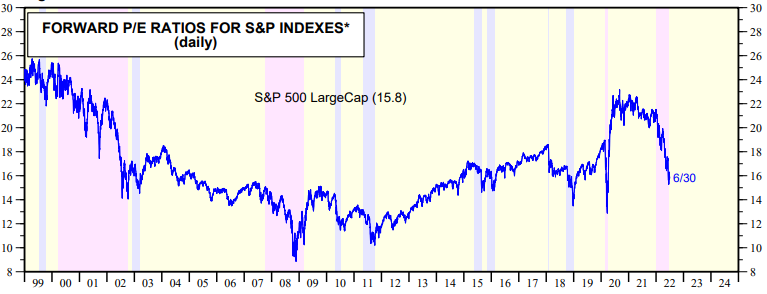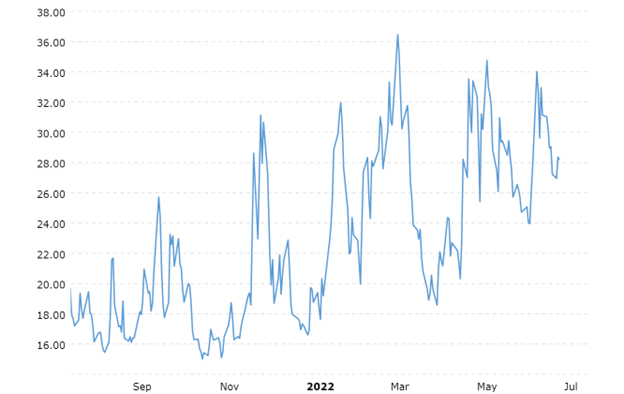Even Winning Teams Occasionally Lose
The stock market has been a winning team for years, generating outsized returns for investors. But so far this year, the winning streak appears to be coming to an end. For 2022, the S&P 500 index is down -21%, including -8% last month.
However, since 2008, the stock market has generally been on a consistent tear, racking up a record of 10 wins, 2 losses (2015 and 2018), and one tie (2011). In recent years, the U.S. stock market has been winning by a large margin (2019: +29%, 2020: +16%, 2021: +27%) and a significant contributor to the team’s win streak has been the Federal Reserve, or the designated hitter (DH).
Jerome Powell, the Fed Chair, has been a very effective clean-up hitter for the stock market, not only leading the stock market team to victories, but also appreciation in almost all global-risk asset classes. Due to keeping interest rates (the Federal Funds Rate target) essentially at 0% over the last few years since the initial COVID-19 pandemic outbreak, many investors have been blaming Mr. Powell for elevated inflation rates.
If that were truly the case, then we probably wouldn’t see the ubiquitous inflation globally, as we do now. Just as you would expect with any baseball team, any single player does not deserve all the credit for wins, nor should any single player receive all the blame for losses – the same principle applies to the Federal Reserve.
Regardless, the stock market’s best hitter is now injured. In addition to pushing interest rates higher, the Fed is hurting the team through its monetary policy of quantitative tightening or QT (i.e., selling bonds off the Fed’s balance sheet). Theoretically, QT should cause interest rates to move higher, all else equal, and thereby slow down growth in the economy, and help tame out-of-control inflation.
The stock market was also thrown a curve ball when Russia invaded Ukraine, which added gasoline to an already flaming inflation fire. Globally, consumers and businesses have witnessed exploding oil/gasoline prices, in addition to escalated food prices caused by a lack of grain and other commodity exports out of Ukraine.
Lastly, a wild pitch has been thrown at the U.S. stock market by China with its zero-COVID policy, which has essentially shut down the world’s second largest economy and further delayed the full reopening of the global economic game. As a result of China’s hardline lockdown stance, global supply chain disruptions have intensified and import prices have mushroomed higher.
Although this all sounds like horrible news, in the game of investing, nobody wins all the time. As history teaches us, the stock market is generally up around 70% of the time. It just happens to be that we are in the middle of a 30% losing period.
Bad News Does Not Mean Bad Stock Market
The majority of economists, strategists, and talking heads on television are forecasting a recession in our economy, either this year or next. This should come as no surprise to any experienced investor, as history teaches us that recessions occur on average about twice every decade.
Long-term investors also understand that stock prices do not always just go up on good news and down on bad news. Stocks can go down on good news, and up on bad news. In fact, over the last 13 years, since the bottom of the 2008-2009 financial crisis, the stock market has increased about six-fold (even after this year’s -21% correction) in the face of some horrendously scary headlines (also see chart below):
- The Ukraine-Russia Conflict.
- COVID-19.
- Elections/Capitol Insurrection.
- Exit from Afghanistan.
- Impeachment.
- China Trade War & Tariffs.
- Inverted Yield Curves.
- N. Korea Missile Launches.
- Brexit.
- ISIS in Iraq.
- Ebola.
- Russia's Takeover of Crimea.
- Double Dip Recession Fears.
- Eurozone Debt Crisis.
S&P 500 Index (1997 – 2022)
Source: TradingEconomics.com
Despite the recent headwinds in the stock market, not all the news is bad. Here are some tailwinds:
-
Profits: Corporate profits remain at or near record levels.
Source: Yardeni.com
-
Inflation: Inflation appears to be cooling as evidenced by declining commodity prices (TR Commodities CRB Index).
CRB Commodities Index (2022)
Source: TradingView
-
Prices: Valuations have come down significantly – Price/Earnings ratio of 15.9 (i.e., stock prices are on sale).
Forward P/E Ratios for S&P Indexes
Source: Yardeni.com
-
Sentiment: Sentiment remains fearful – a contrarian buy indicator (an elevated VIX – Volatility Index can signal buying opportunities). As Warren Buffett says, “Be fearful when others are greedy, and greedy when others are fearful.”
VIX – Volatility Index (2021 – 2022)
Source: Macrotrends
Even though the U.S. stock market has been a long-term winner, investors have been betting against the winning team by selling stocks. As mentioned earlier, recessions, if we get one, are common and nothing new. The -21% correction in stock prices is already factoring in a mild recession, so we have already suffered near-maximum pain.
Could prices go lower? Certainly. But should you quit a 26-mile marathon at mile 25 because the pain is too intense? In most instances, the answer should absolutely be “no” (see also No Pain, No Gain).
Eventually, the Fed will stop raising interest rates, inflation will cool, the Russia-Ukraine war will be resolved, and solid growth will return. While many people are betting the stock market will lose this year, many long-term investors recognize betting on stock market success is a winning strategy over the long-run, especially when prices are on sale.
Disclosure: Sidoxia Capital Management at the time of publishing had no direct position in BRK-A/B.
Sidoxia Capital Management (SCM) and some of its clients hold positions and ...
more








